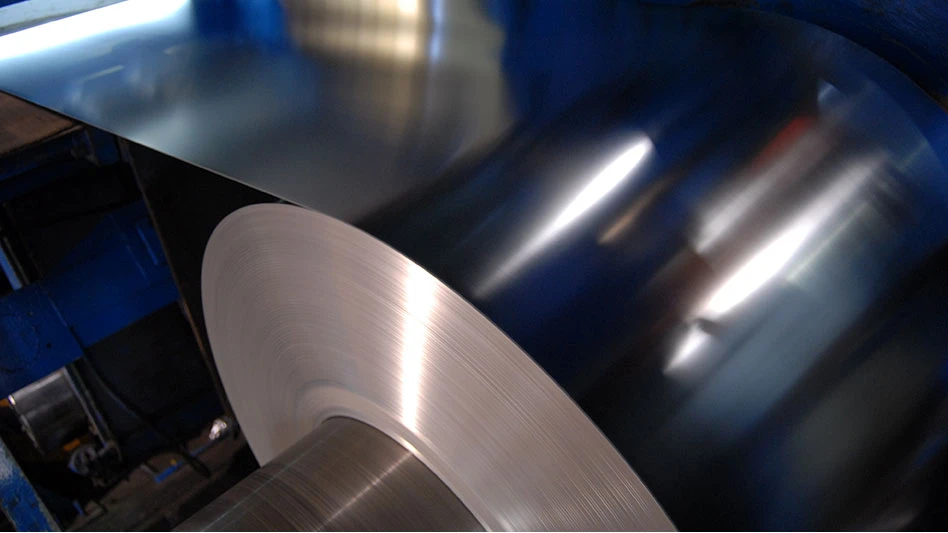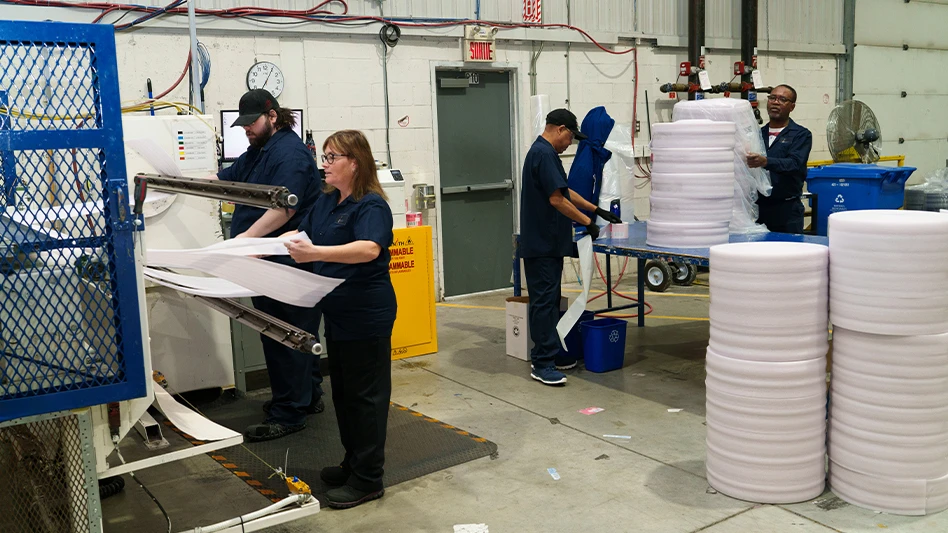
Presenters during the Spotlight on Aluminum during ISRI2019, the annual convention and exposition hosted by the Institute of Scrap Recycling Industries (ISRI), Washington, April 8-11 in Los Angeles, predicted additional investment in secondary and primary aluminum production and speculated as to whether the current market represents the new normal for the aluminum recycling sector.
The session, moderated by Jason Schenker, president of Prestige Economics, Austin, Texas, featured Steve Deacon, nonferrous president for EMR USA, Bellmawr, New Jersey; Richard Mayenknecht, global director of aluminum for Nemak, which is based in Monterrey, Mexico; and Andrew McKee, president of the Chicago-based Materials Trading division of Schupan & Sons, Kalamazoo, Michigan.
“When we look at the European aluminum market and we look at the primary side, we’ve seen billet prices under pressure,” Deacon said. “We see closed loop supply chain management that has reduced the need for external scrap.
“On the secondary side,” he continued, “you see a continued weakening of the automotive sector ... that is impacting the demand for secondary aluminum items there that are flooding out into the Far East.”
Deacon said China was “the elephant in the room,” affecting demand for U.S. scrap. “We’ve seen that void filled not only by India but other emerging Asian markets.”
Investments are being made throughout the world on the secondary and primary sides of the aluminum business, he added.
McKee agreed, saying he believed the wide spreads on aluminum scrap would attract new investments from secondary aluminum producers.
However, both men acknowledged that government policy is playing a larger role in spurring these investments than supply and demand dynamics alone.
“Gone are the days when I believe you are looking strictly at utilization capacity and margins, and here are the days when you are talking about Facebook and Twitter, and you’re talking about government policy,” Deacon said. “Across the world and not just in the U.S., government policy is really driving that supply-demand dynamic and its effect on the U.S. scrap business.”
Deacon mentioned the shift among U.S. zorba producers to create a product that had greater demand globally last summer as the mixed metal was targeted by the Chinese government for higher tariffs as well as for import restrictions that are set to go into place this year. “It created a supply issue in the secondary market in the U.S. that lasted the better part of a year.”
McKee also pointed to another supply issue that has been affecting the U.S. aluminum scrap sector. He said the impact of auto body sheet scrap on the market has been touching every aluminum scrap commodity in North America. “No scrap today operates in a vacuum,” McKee said, adding that the automotive sector’s commitment to aluminum auto body sheet “has generated tremendous amounts of scrap that are finding its way into nearly every grade of aluminum scrap in our industry.”
He said he believed the Section 232 tariff President Trump introduced on aluminum imports into the U.S. in 2018 has been good for the U.S. aluminum scrap sector, spurring demand as the cost of primary aluminum has increased. “Scrap will be best alternative to help close gap on global production prices,” McKee said.
However, he also predicted that mills’ scrap quality requirements will become more stringent. “Mills will continue to demand higher quality, tighter specs and easier to handle forms of scrap to become more automated in their scrap charging,” McKee said. Mills would increase their degree of data collection on contamination and fallout on loads, pricing that information into suppliers’ loads, he predicted.
McKee said it was no longer “attractive to promote collection on peddler grades of scrap,” adding that the “very real consequences of low pricing are making it difficult to get scrap in the door.”
He questioned whether the current buyer’s market was “the new normal” for the aluminum scrap sector until more casting and rolling capacity could be built.
Mayenknecht represented aluminum scrap consumer Nemak, which operates 38 manufacturing facilities in 16 countries producing aluminum components for the global automotive industry, specializing in powertrain and body structure applications. He said 25 percent of new vehicles sold worldwide have a Nemak component. Within North America, the company has 19 facilities in Canada, the U.S. and Mexico. It also operates 14 facilities in Europe, two in South America and three is Asia.
Mayenknecht said Nemak’s global operations consume 860,000 metric tons of aluminum annually. The company’s melting facility in Garcia, Mexico, near Monterrey, has 400,000 metric tons of melting capacity annually, with primary alloys comprising 25 percent of this figure and secondary alloys accounting for 75 percent.
In addition to operating scrap sorting lines and densifying equipment, Nemak has two delacoring rotary kilns, 14 reverbatory furnaces, six rotary furnaces and two ingot casting lines at its Garcia plant. He said the company’s mission is to move as much primary foundry production to secondary foundry production as possible, “which is good for everyone in this room, I would think.”
The aluminum scrap grades Nemak primarily uses include wheels, twitch, taint/tabor, MLC (mixed low-copper clips), aluminum cans and extrusions.
Mayenknecht challenged the scrap processors in attendance to do a better job of removing airbag canisters from the twitch they supply and wondered whether the mercury switch model should be adopted to incentivize the removal of airbags from end-of-life vehicles.
Schenker offered a macro look at the global and U.S. economies and the expected effect on the aluminum sector in his introductory remarks. He outlined some of the critical dynamics at play, revisiting what he said were four important figures that he mentioned during his presentation at ISRI2018. At that time, the IMF (International Monetary Fund) predicted 2019 gross domestic product (GDP) growth of 3.9 percent. “That was despite the trade war, despite the trade risks,” Schenker said. “Since then, things have changed.”
He noted that the IMF’s updated forecast for global GDP, released April 9, has been dialed downward to 3.3 percent.
The wage inflation figure Schenker referred to in 2018 was 2.9 percent. “That was a number that triggered a massive sell-off in equities in January of last year, although equities later recovered,” he said.
Schenker said Prestige predicted four rate hikes by the U.S. Federal Reserve Bank in 2018 in an effort to address higher inflation, which was in line with what the Fed did. This year, however, Prestige is not predicting any rate hikes or rate cuts. “The reason that we don’t expect that is because wage inflation remains high,” he said.
At the time of ISRI2018, wage inflation stood at 2.2 percent, but as of this year’s event, that number stood at 3.2 percent, which Schenker said was good for the economy because more than two-thirds of the U.S. economy is consumer-based.
“The 120 I mentioned [last year]? That’s the Dow Jones; it’s a critical technical average that we crossed below when the trade mess started,” he said, adding that that number was above 120 as of early April.
The final figure Schenker revisited was the Fed’s assessment of trade risk, which was zero as of last year’s convention. “We’ve seen how that has changed significantly,” he said. “It has had a big impact on the economy; it has had a big impact on aluminum.”
Schenker advised attendees to keep an eye on purchasing managers’ indices (PMIs) for the U.S., China and the Eurozone. While China’s PMI showed contraction earlier this year, it rebounded in March. The Eurozone contracted in February and worsened in March, and the U.S. has remained positive on a relative basis, he said.
“This is part of the reason we saw aluminum prices fall on trend last year, even though they bottomed a few months ago and we’ve seen a modest trend of higher lows,” Shenker said.
ISRI2019 was April 8-11 at the Los Angeles Convention Center. The 2020 event is planned for April 27-30 in Las Vegas.
Latest from Recycling Today
- Nucor names new president
- DOE rare earths funding is open to recyclers
- Design for Recycling Resolution introduced
- PetStar PET recycling plant expands
- Iron Bull addresses scrap handling needs with custom hoppers
- REgroup, CP Group to build advanced MRF in Nova Scotia
- Oregon county expands options for hard-to-recycling items
- Flexible plastic packaging initiative launches in Canada





